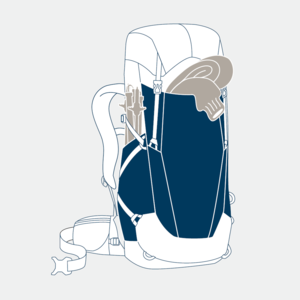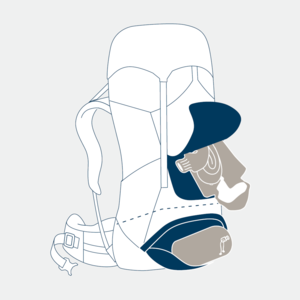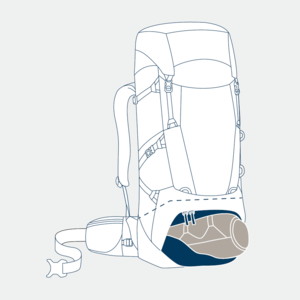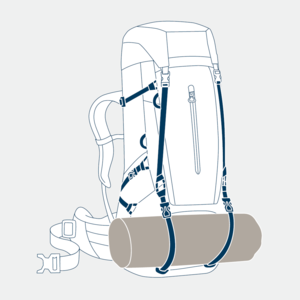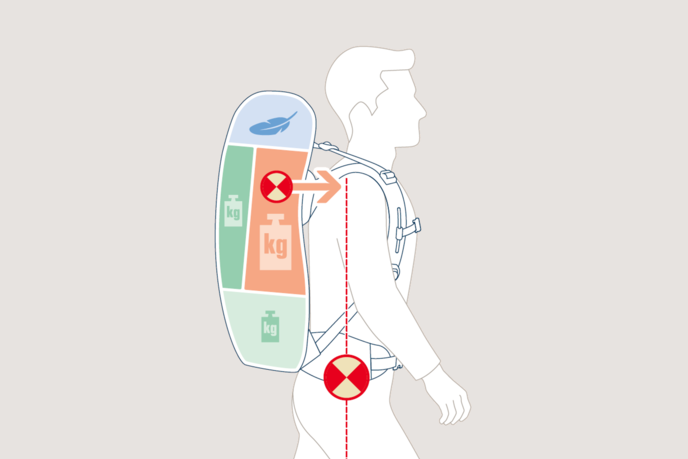DEUTER TREKKING BACKPACK ADVICE

DEUTER TREKKING BACKPACK ADVICE
Looking for a trekking backpack? Planning your next adventure and still have a few questions about adjustable back systems, packing weight or types of intended use? Then you’ve come to the right place. We’ll try to answer all your questions on trekking backpacks and help you find the perfect pack for your next trekking or hiking adventure.
Frequently asked questions
- What size trekking backpack do I need?
- What kind of trekking backpack is suited to what type of activity?
- How do I adjust my trekking backpack and what is the correct way to carry it?
- How do I pack my trekking backpack correctly?
- How many kilograms can I pack in my trekking backpack?
- What gear do I need to pack for a trek?
- What are the differences between deuter’s trekking backpacks?
- What trekking accessories are there?
WHAT SIZE TREKKING BACKPACK DO I NEED?

WHAT SIZE TREKKING BACKPACK DO I NEED?
Choosing the right backpack isn’t just about capacity. The larger the pack, the more important a well-fitting, adjustable back system is. A back system with anatomically S-shaped shoulder straps that wrap around the shoulder will create superior carrying comfort allow for unrestricted range of movement. And that’s why the back length of a backpack is also key.
HOW DO I MEASURE BACK LENGTH?
Measurement POINT 1 neck VERTEBRA
Tilt head down. The C7 vertebra bulges below the base of the neck.
Measurement POINT 2 LUMBAR region
Use a belt to help you measure. Position the belt across the top of the hip bone. This is at the same height as the L3 lumbar vertebra.
A measuring tape can then be positioned on the C7 vertebra, and the measurement taken between this and the top of the belt or top of the hip bone.
You can measure your back length by following these instructions.
Once you have established your back length, you can use our size chart to see what size trekking backpack is right for you.

TYPES OF TREKKING
Whether it’s a long-distance thru-hike, hut-to-hut mountain hike, following a pilgrim’s trail or a full-on wilderness expedition, deuter has a trekking backpack that fits the bill. To ensure you enjoy your experience to the full, we’ve focused on maximum comfort and carefully considered features. Adjustable back systems create a tailored fit and make it easier and more comfortable to carry heavier loads for longer periods of time. Check out our trekking backpack models that cover a range of uses:
CORRECT WAY TO WEAR A BACKPACK
IT’S IN THE BACK SYSTEM ADJUSTMENT
With loads of 10 kg+ or when walking longer distances, ensuring the back system is correctly adjusted to your size is critical to carrying comfort. That’s why we equip all 35 liters+ backpack models with a back length adjustment system. With smaller packs, doing away with adjustable back lengths keeps the overall weight down. In such cases, back panel length can be determined by selecting a men’s/ regular (REG), women’s (SL,) or extra long (EL) model. Our backpacks are designed with an average athletic person’s proportions in mind.
VARISLIDE SYSTEM
Precision-adjustable back length for a perfect fit on any back length:
- Lift the plastic buckle at the center of the back panel.
- At the same time, either raise or lower the shoulder strap harness to the desired position.

VARIQUICK SYSTEM
On backpacks featuring the VariQuick system, follow these steps when adjusting the back length:
- Pull back the hook & look flap on the back panel.
- Thread the end of the strap through the desired loop in an upward direction, pull tight and fasten again.

CLIP & LOOP SYSTEM
For our ultra-light trekking backpacks, we use a Clip & Loop system to adjust the back length for tailored comfort. Simply clip the carabiners into the loops at the desired height.
| Loop | 1 | 2 | 3 |
| Men's back length | 44 cm | 46 cm | 48 cm |
| Women's (SL) back length | 40 cm | 42 cm | 44 cm |

HOW HEAVY SHOULD A TREKKING BACKPACK BE?
TREKKING Load categories
WHAT DO THESE CATEGORIES WITHIN OUR TREKKING BACKPACKS MEAN?
With our load categories, we don’t mean the maximum load our trekking backpacks can take – they can handle way more than anyone would want to carry. They are intended as a guideline. It’s all about carrying comfort. The categories are decided based on a combination of the following:
- Build and sturdiness of the back system
- Expected carrying duration. e.g., trekking backpack compared to travel backpack.
- Personal requirements e.g., thru-hikers will want the lightest backpack possible, trekkers will place emphasis on comfort.
- Individual’s fitness levels. e.g., the aspirations of an expedition team member will be greater than a hobby hiker’s.
- Finally, they are also based on the usual or appropriate equipment that is required for that activity.
Our load categories are only intended as a guide to help find the right trekking backpack. We would always recommend that customers test out carrying a backpack with a realistic load before buying.
Load category 1 |
Load category 2 |
Load category 3 |
|
Sturdy frame, combined with padded hip fins for good load transfer • Touring backpacks, distance hiking |
Reinforced frame directly connected to sophisticated padded hip fins for better load transfer over longer distances • Trekking, work and travel, longer journeys |
High load-bearing frame directly connected to reinforced, sophisticated padded hip fins and wider-format shoulder straps, plus increased cushioning through special back padding, for maximum load transfer on long treks • Self-supported trekking, long journeys |
“RECOMMENDED LOAD UP TO”
WHAT DO OUR RECOMMENDED LOAD FIGURES MEAN?
These are not the maximum weight that can be carried in a particular backpack, but instead the load that is most common for that particular application. It is the weight that can be carried in comfort over several hours in a particular backpack model, when correctly fitted. When selecting a backpack model, in addition to load weight, the anticipated carrying duration and target group-specific requirements for carrying comfort are also taken into account. So, the ‘recommended load’ figures serve as an aid in finding the right backpack.
PACKING LISTS: WHAT YOU NEED TO TAKE ON A TREK
IN GENERAL, FOR ANY TREK:
Take only what you need – and nothing you don’t need! Together with state certified mountain guides from the German Association of Mountain and Ski Guides, we’ve compiled packing lists and some well-earned top tips. Please note that all weights are only intended as a guide and may vary. As a general rule, the higher quality the equipment, the more lightweight it will be. Have fun on your adventures!
WHAT ARE THE DIFFERENCES BETWEEN DEUTER’S TREKKING BACKPACKS?
Our trekking backpacks come with either the Aircomfort or Aircontact back system, and also differ in size, features and handling. The characteristics of each backpack are geared towards a particular type of use.

Recommended Load
Load category 1
Up to 15 kg
Type of use
Thru-hiking, distance hiking, fast-packing, trekking with accomm./ tarp
Key Features
• Hydration compatible
Back System
• Clip & Loop adjustable back length
• Ergonomic lumbar pads
• Slender, ergonomic hip fins for moderate loads
• VariFlex hip fins with ECL (Ergonomic Comfort Lock)

Recommended Load
Load category 1
Up to 15 kg
Type of use
Hut-to-hut trekking, alpine traverse, pilgrim route, trekking with accomm. & food
Key Features
• deuter Aircontact back system
• Lightweight
• VariQuick
• Ice axe and trekking pole attachment
• Detachable backpack lid doubles as day pack using front straps
• Separate bottom compartment
• Hydration compatible
Back system
• VariQuick back length adjustment
• Ergonomic lumbar pads
• Slender, ergonomic hip fins for moderate loads
• ECL (Ergonomic Comfort Lock)

Recommended load
Load category 2
Up to 20 kg
Type of use
Distance hiking, pilgrim route, trekking journey, with accomm. & food
Key Features
• deuter Aircomfort back system
• VariSlide back length adjustment
• Separate bottom compartment
• Front zipper opening
• Detachable rain cover
• Hydration compatible
Back system
• Full contact in the lumbar region
• Padded, firmer hip fins
• VariFlex hip fins with ECL (Ergonomic Comfort Lock)

Earlier models: Aircontact until 2021
Recommended Load
Up to 20 kg for earlier models
Up to 25 kg
Type of use
Tent-trekking, lodge trekking, backpacking, with accomm. / tent
Key Features
• deuter Aircontact back system
• VariSlide back length adjustment
• Modular gear straps to attach a sleep mat or tent, or to compress the load in the base of the pack
• Height-adjustable, detachable lid for extra 10 liters capacity (safely secured under the lid)
• Separate bottom compartment
• Large 3-liter volume detachable hip fin pockets (>55 L)
• J-shaped zipper opening on front (>55 L)
• Hydration compatible
Back system
• VariSlide precision-adjustable back length
• Ergonomic lumbar pads
• Extra-firm, ergonomically shaped hip fins designed for heavy loads
• Cushioning, load distributing Air Spacer mesh
• VariFlex hip fins with ECL (Ergonomic Comfort Lock)

Earlier models: Aircontact Pro until 2021
Recommended Load
Up to 30 kg
Type of use
Wilderness trekking, expeditions, work & travel, self-supported with tent
Key Features
• Large front opening
• Separate bottom compartment
• Modular gear straps to attach a sleep mat or tent, or to compress the load in the base of the pack
• Two stretch side pockets and zippered front pocket with extra 5 liters capacity, large bellows side pockets for extra space
• Height-adjustable, detachable lid
• Two large detachable hip fin pockets (3 L)
• Spindrift collar with compression strap to secure extra 15 liters capacity
• Day pack inside lid compartment
• Detachable rain cover
Back System
• VariSlide precision-adjustable back length
• Sturdy, ergonomic lumbar pads
• Hip fins designed for heavy loads, with leg recesses
• Load distribution across wide surface area on the back to protect the spine
• Cushioning, load distributing Air Spacer mesh
• VariFlex hip fins with ECL (Ergonomic Comfort Lock)

